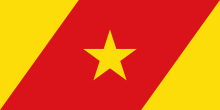Debarq (woreda)
Debarq (Amharic: ድባርቅ) is one of the woredas in the Amhara Region of Ethiopia. It is named after its largest town, Debarq. Part of the Semien Gondar Zone, Debarq is bordered on the south by Dabat,
Debarq ድባርቅ | |
|---|---|
Woreda | |
 Flag | |
| Zone | Semien Gondar |
| Region | Amhara Region |
| Area | |
| • Total | 1,187.93 km2 (458.66 sq mi) |
| Population (2012 est.) | |
| • Total | 159,091 |
on the west by Tegeda, on the northwest by the Tigray Region, on the north by Addi Arkay, and on the east by Jan Amora.
This woreda is crossed by the Lamalmo Mountains, which form the western end of the Semien. Rivers include the Zarima.
Due to its inaccessibility and the lack of the most basic infrastructure, in 1999 the Regional government classified Debarq as one of its 47 drought-prone and food-insecure woredas. To alleviate this situation, the Amhara Credit and Saving Institution SC, a micro-finance institution, opened an office in Debarq in the late 1990s.[2] On 27 May 2009, the Ethiopian Roads Authority announced work to repair and upgrade the road between Debarq and Gondar had begun. The work on the 99 kilometres (62 mi) of road would be done by Sino-Hydro International, a Chinese construction company, with engineering consultancy by a South African company and an Ethiopian firm, Omega Engineers Consulting. The budget for the work is approximately 690 million Birr.[3]
Demographics
Based on the 2007 national census conducted by the Central Statistical Agency of Ethiopia (CSA), this woreda has a total population of 159,193, an increase of 31.83% over the 1994 census, of whom 80,274 are men and 78,919 women; 20,839 or 13.09% are urban inhabitants. With an area of 1,461.18 square kilometres (564.16 sq mi), Debarq has a population density of 108.95, which is greater than the Zone average of 63.76 persons per square kilometer (0.39 sq mi). A total of 33,822 households were counted in this woreda, resulting in an average of 4.71 persons to a household, and 32,573 housing units. The majority of the inhabitants practiced Ethiopian Orthodox Christianity, with 94.8% reporting that as their religion, while 5.2% of the population said they were Muslim.[4]
The 1994 national census reported a total population for this woreda of 120,754 in 21,646 households, of whom 60,372 were men and 60,382 women; 14,474 or 11.99% of its population were urban dwellers at the time. The largest ethnic group reported in Debarq was the Amhara (99.42%); all other ethnic groups made up 0.58% of the population. Amharic was spoken as a first language by 99.46%; the remaining 0.54% spoke all other primary languages reported. 93.78% practiced Ethiopian Orthodox Christianity, and 6.16% of the population said they were Muslim.[5]
Notes
- Geohive: Ethiopia Archived 2012-08-05 at the Wayback Machine
- "Underdeveloped, Drought Prone, Food Insecure: reflections on living conditions in parts of the Simien Mountains" UNDP-EUE Report October 1999 (accessed 15 May 2009)
- "Physical work on Gondar-Debarq; Sanja-Qeraqer kicks off" Archived 2009-05-30 at the Wayback Machine, Ethiopian News Agency, 27 May 2009 (accessed 30 May 2009)
- Census 2007 Tables: Amhara Region Archived November 14, 2010, at the Wayback Machine, Tables 2.1, 2.4, 2.5, 3.1, 3.2 and 3.4.
- 1994 Population and Housing Census of Ethiopia: Results for Amhara Region, Vol. 1, part 1 Archived November 15, 2010, at the Wayback Machine, Tables 2.1, 2.7, 2.10, 2.13, 2.17, Annex II.2 (accessed 9 April 2009)